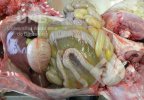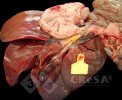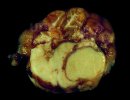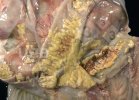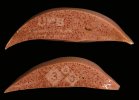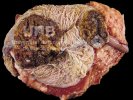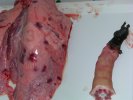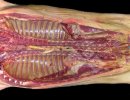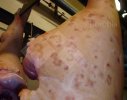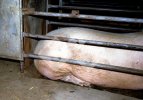Fibrinous pericarditis - Atlas of swine pathology

Where: cardiovascular system
Possible causes: Enzootic Pneumonia (EP)Glässer diseaseStreptococcal infectionsOther
The autopsy signs are consistent with pericarditis and diffuse serositis in pigs caused by the bacterium Haemophilus parasuis. This common disease is also known as Glasser’s disease. The hospital pens of the nursery area may contain many runted, sick and dull pigs, without a clear pattern of diarrhoea or coughing. At autopsy, a dull pale thickening in patchy strands and sheets across the serosal linings of the lungs, heart and abdominal organs is noted. In severely affected pigs, this patchy grey-yellow thickening is thicker and can resemble two pieces of bread and butter stuck together. The bacteriology laboratory may have difficulty at culturing this bacterium from fresh samples. Piglets in stable H parasuis herds are usually infected within a few days of birth from their mother and develop a sub-clinical infection and acquire protective immunity. However, where piglets are mixed with piglets from other breeder pig groups, which may have different strains of H parasuis, then piglets will lack appropriate maternal antibody and develop Glasser’s disease. Use of in-feed antibiotic therapy to control this disease in weaner pigs is currently an essential part of pig raising. This form of control has the advantages of not requiring detailed knowledge of maternal antibody status, nor of the dominant strains of H parasuis present on the affected farm. Other causes of fibrinous pericarditis may include Streptococcus suis, Mycoplasma hyopneumoniae, Mycoplasma hyorhinis.





